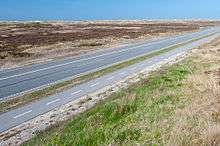Cycling in Denmark
Cycling in Denmark is very popular for both recreational and commuting and is often compared to that of the Netherlands. Because of this (or perhaps the other way around) Denmark has a quite extensive bicycle infrastructure, including a network of nationally appreciated bicycle routes extending more than 12,000 km (7,500 mi). In comparison Denmark's famous coastline is only approx. 7,500 km (4,500 mi)!
In urban areas
- For biking specifically in Copenhagen, see Cycling in Copenhagen
In many urban areas, cyclist have their own paths/ways. Even outside of city centres you will find bikeways, which are separated from the rest of the road, with either a thick line, a different color or being raised to something like pedestrian walk level. The width of the bikeway varies a lot, depending on where you are. They can be observed as small as 80cm (2.5ft) but also wider than 3m (10ft). In general bikes have their bikeways for themselves, but on occasion you will find that cars are (partially or totally) parked on the bikeways, and cars parked next to the bikeway may also unexpectedly open their doors, causing dangerous situation for bicyclists. Even though you are on "your own turf" as a cyclist, you should be aware of the surroundings.
In rural areas

Denmark has approx. 2,500 km (1,500 mi) dedicated bikeways in the rural areas. Though obviously less common than in the cities, they still form a popular place for getting around, and especially along the coastlines and on the islands of Denmark you will find a lot of those, creating some unique travelling experiences. Be aware, that in the countryside, outside of the dedicated bikeways, cycling can sometimes be a dangerous activity. Although most rural roads are in good condition, and the majority of drivers are used to cyclists, the roads are often narrow and winding and cars are fast driving. You can get dedicated cycling maps of Denmark at most tourist agencies or you can use the Danish Cyclistic organization online tool to plan your route.
Connecting with other forms of transport
Most train systems and a few bus systems, allow you to bring your bike along. For the S-trains of Copenhagen it's free, but be aware of limitations during rush hour. For regional and intercity trains the price varies somewhere between 12 DKK (2 USD) and 60 DKK (11 USD). Parts of the train system requires that you book your bike in advance and will fee you 750 DKK (140 USD) if you don't, so make sure to ask in advance. Also note that tandem-bikes and cargo bikes are twice the price, so be specific when booking (or that 750 DKK fee will hit you again).
Mountainbiking

Denmark being a relatively flat land, doesn't sport much mountain biking territory. Singletrack.dk has a good map, showing user-made places, suitable for mountain biking. Though the page is only in Danish, the maps are pretty straightforward. Most mountain biking paths in Denmark are in mostly moist forest areas and/or wetlands, so be prepared for getting wet and a cleaning of your bike afterwards.
Mountainbike routes in nature are usually outmarked by clear signs and be aware that it is often illegal to mountainbike outside these marked tracks. There are several reasons for this policy: Many nature sites are also popular with other people, and mountainbiking on hiking trails for example are prone to cause conflict and accidents. Another important reason is that some nature sites are vulnerable to heavy traffic and mountainbiking would stress and deteriorate local ecosystems. This is also the case in most hilly forested areas, where mountainbiking cause deep erosion, exposing the upper earth layers to further accelerated soil deterioration from rainfalls.
Road bicycle racing
The same flatness that makes Denmark a bad sport for mountain biking, makes it rather popular for road racers. As the rural roads are almost always in good or very good shapes, Denmark is quite popular for road racers. Be aware though that not all car-drivers are good at handling the fast bikes, and especially at sharp turns and hilltops, one should be aware of car traffic from both sides.
Getting a bike
Most cities and tourist areas offer bike rentals. Prices varies a lot, with as low as 65 DKK (12 USD) per day and up to 275 DKK (50 USD) depending on area and season. Some bike rentals will also require you to do a deposit which again varies a lot. Some places it is 3 days rental and other places it may be as much as a 1000 DKK (180 USD). The excess (deductible, in Danish selvrisiko) may also vary a lot. For some places it's included in the deposit, for other places it will be an amount withheld for a credit card. Ask around and make sure you get all details.
The majority of the bigger cities and even some of the smaller one, also provides a community public bicycle sharing scheme of some sort or another. Again, prices varies a lot ranging from 20 DKK (4 USD) deposit using a coin-insert on the bike and up to a 100 DKK (18 USD) deposit. As with the latter in some places, such as Frederikshavn it must be paid at a counter in one of the manned sites, but don't feel completely cheated though for depositing 5 times the amount: The bicycles are usually in a far better condition and quality.
Bike thefts
Bike theft is quite common especially in the bigger cities. In general more than 15,000 bikes are dumped in just Copenhagen and Aarhus. The vast majority of those are stolen. Guarded bike parking areas are extremely rare, so the best approach is to park in a closed area if possible. Ask at your selected choice of accommodation. They will most likely be used to it, and will be able to provide a closed bike parking area. If you have to park at the street, having double-locks is a good idea; one lock is a chain-/tubelock and goes into a fixed installation and the other is a common fixed lock on the bike. If you only have one lock, go for the chain-/tubelock. Most bike rental companies will be able to provide an extra lock for a small fee, but it might worth it - especially if you are renting a bike with a high excess.
Stay safe
In 2012, 21 cyclists were killed in Denmark in traffic accidents. Compared to the almost 5,000,000 km (3,100,000 mi) cycled in Denmark every year, the risk of getting killed in traffic while cycling is extremely low. A few pieces of advice on safety are still in order, though:
- Be aware. Drivers in Denmark - especially in the cities - are rather used to cyclists, but expect them to react quickly. If you are a bit unsure, find a parking lot and take a few trips around it, before throwing yourself into the traffic.
- Be visible. Cyclists in Denmark dress in a specific style while biking. In Copenhagen somebody has even fashioned it Copenhagen Cycle Chic. You don't very often see people in white vests or similar apparel, but if you are biking in dark areas, remember to bring lights on your bicycle and also consider putting a reflector of some form on your clothing. Also don't hide around corners but go boldly out, so that drivers can clearly spot you. If you are driving on rural areas, bright visible markings - and perhaps a little flag - can be a good idea.
While persistent sub-zero temperatures are rare, Denmark can get windy and rainy. Remember the Nordic proverb "There is no such thing as bad weather, only bad clothes".
The legal stuff
The Danish traffic code (in Danish Færdselsloven) actually hosts a specific chapter on cycling. By actual observation of traffic, especially in the bigger cities, you will find that cyclists follow a somewhat more "anarchistic" mindset. The specifics from the traffic code on bicycles are:
- Two bicycles may only drive in parallel side-by-side if it can be done safely, without harassing other traffic.
- Bicycles must stay right.
- If turning left in an intersection, the bicyclist must go straight over, make a 90 degree turn and go straight over again. The latter part of course only when it can be done safely.
- The bicyclist must have both feet on the pedals and at least one hand on the handlebar.
- It's not allowed to bicycle on pedestrian walkways or footpaths.
- Bicyclist are not allowed to attach themselves to other vehicles while driving.
- When leaving the bike it must be locked (yes - that is actually a part of the traffic code; §49, 7 if you know Danish and want to check it out yourself!).
- Children under the age of 6 years, must not bicycle unsupervised, and the supervisor must be at least 15 years of age.
- The bike may only carry as many people as there are saddles/seats for.
- The bike may not carry an object wider than 1m or longer than 3m.
The general parts of the traffic code also apply to bicycles, such as don't cross intersections on red, no right on red, stop for pedestrians crossing in pedestrian crossings and stop for pedestrians leaving or entering a bus. You will find that a lot of the local cyclists doesn't strictly adhere to the traffic code, but choose a more "practical" approach to it (if nothing else, then from their perspective).
Note that unlike other countries, such as the Netherlands, Denmark does not have strict liability for car-drivers, but instead has a system that partially resembles it. Liability is divided into two parts: In regards to the Danish traffic code in regards to the mandatory car liability insurance (in Danish ansvarsforsikring). In example in an accident, where a car going the right way in a one-way street and hits a cyclist going the wrong way, there will be a liability for both the car's owner (who will not necessarily be the driver) and the cyclist. This is due to a requirement for liability insurance for vehicle owners; the insurance companies will always apply this and thus make the vehicle's owner liable for damages. However the cyclist may be deemed liable by the Danish legal system for violating the one-way restriction while the driver may escape charges. In that case the car owner's insurance company may seek reimbursement from the cyclist. However in the majority of the accidents the car driver is found liable in both regards; in 1999, in 90% of the accidents involving cars and cyclists the car-drivers were found fully liable.
See also
- Cycling in Denmark - a good guide by the Cyclistic Denmark
- Cycling in Denmark - a different but also very good guide by Visit Denmark
- Driving in Denmark
.jpg)




